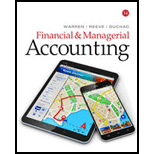
Concept explainers
Petty cash fund: Petty cash fund is a fund established to pay insignificant amounts like postage, office supplies, and lunches. In day-to-day life, it becomes difficult to use checks for daily expenses. Therefore, companies maintain some minimum amount of funds in the hand for such daily expenses. These funds are called as petty cash funds. These funds are managed by custodian. This system is otherwise called as imprest system.
To journalize: The petty cash transactions.
Explanation of Solution
| Date | Account Title and Explanation | Post Ref | Debit ($) | Credit ($) | |||
| July | 1 | Petty Cash | 1,100 | ||||
| Cash | 1,100 | ||||||
| Open petty cash fund. | |||||||
Petty Cash is an asset and is increased by $1,100. Therefore, debit the Petty Cash account by $400. Cash is an asset and decreased by $1,100. Therefore, credit the Cash account by $1,100.
Journal entry 2: Record the cash sales.
| Date | Account Title and Explanation | Post Ref | Debit ($) | Credit ($) | |||
| July | 12 | Cash | 8,220 | ||||
| Cash Short and Over | 28 | ||||||
| Sales | 8,192 | ||||||
| (To record the cash sales.) | |||||||
Cash is an asset and is increased due to cash sales. Thus, cash is debited with $8,220. Therefore, debit Cash account by $8,220. Sales as per cash records are $8,192. Thus, sales is credited with $8,192. The difference of $28 is credited with $28. Cash short and over is determined as follows:
Journal entry: Replenishment of funds.
| Date | Account Title and Explanation | Post Ref | Debit ($) | Credit ($) | |||
| July | 31 | Store Supplies | 580 | ||||
| Delivery Expense | 225 | ||||||
| Office Supplies | 140 | ||||||
| Miscellaneous Administrative Expense | 88 | ||||||
| Cash Short and Over | 20 | ||||||
| Cash | 1,053 | ||||||
| To record the replenishment of the petty cash fund. | |||||||
Store supplies and Office Supplies is an asset and it increases the value of asset. Therefore, debit store supplies and office supplies by $580 and $140 respectively. Delivery Expense is an expense and it decreases the value of equity. Therefore, debit Delivery Expense by $225. Miscellaneous administrative expenses is an expense and decreases the equity by $88. Thus, debit miscellaneous administrative expense with $88. Cash Short and Over decreases the value of equity. The cash is short by $20. Therefore, debit Cash Short and Over by $20. Cash is an asset and decreased by $1,053. Therefore, credit the cash account by $1,053.
Working notes for cash spent and cash short and over are provided below:
Calculate the cash spent as below:
Calculate the total payments.
| Payments | Amount ($) |
| Store Supplies | 580 |
| Delivery Expense | 225 |
| Office Supplies | 140 |
| Miscellaneous Administrative Expense | 88 |
| Total payments | 1,033 |
Next, calculate cash short and over.
Determining of petty cash before replenishment involves two steps. First, calculate the total payments. Then determine the difference between imprest balance and total payments. This amount is petty cash fund before replenishment. Office supplies include amount spent for two boxes of stationery, and printer cartridges. Entertainment expense include office party and dinner expenses.
Journal entry 2: Record the cash sales.
| Date | Account Title and Explanation | Post Ref | Debit ($) | Credit ($) | |||
| July | 12 | Cash | 10,232 | ||||
| Cash Short and Over | 9 | ||||||
| Sales | 10,241 | ||||||
| (To record the cash sales.) | |||||||
Cash is an asset and is increased due to cash sales. Thus, cash is debited with $10,232. Therefore, debit Cash account by $10,232. The difference of $9 and is debited. Sales as per cash records are $10,241. Thus, sales is credited with $10,241. Cash short and over is determined as follows:
Journal entry 1: Decrease in petty cash
| Date | Account Title and Explanation | Post Ref | Debit ($) | Credit ($) | |||
| July | 1 | Cash | 150 | ||||
| Petty cash | 150 | ||||||
| Open petty cash fund. | |||||||
Petty Cash is an asset and is increased by $1,100. Therefore, debit the Petty Cash account by $400. Cash is an asset and decreased by $1,100. Therefore, credit the Cash account by $1,100.
Want to see more full solutions like this?
Chapter 7 Solutions
Financial & Managerial Accounting, Loose-Leaf Version
- Can you demonstrate the accurate method for solving this financial accounting question?arrow_forwardPlease help me solve this general accounting question using the right accounting principles.arrow_forwardPlease provide the solution to this general accounting question using proper accounting principles.arrow_forward
 Financial AccountingAccountingISBN:9781337272124Author:Carl Warren, James M. Reeve, Jonathan DuchacPublisher:Cengage LearningCentury 21 Accounting Multicolumn JournalAccountingISBN:9781337679503Author:GilbertsonPublisher:Cengage
Financial AccountingAccountingISBN:9781337272124Author:Carl Warren, James M. Reeve, Jonathan DuchacPublisher:Cengage LearningCentury 21 Accounting Multicolumn JournalAccountingISBN:9781337679503Author:GilbertsonPublisher:Cengage College Accounting (Book Only): A Career ApproachAccountingISBN:9781337280570Author:Scott, Cathy J.Publisher:South-Western College Pub
College Accounting (Book Only): A Career ApproachAccountingISBN:9781337280570Author:Scott, Cathy J.Publisher:South-Western College Pub College Accounting, Chapters 1-27AccountingISBN:9781337794756Author:HEINTZ, James A.Publisher:Cengage Learning,Principles of Accounting Volume 1AccountingISBN:9781947172685Author:OpenStaxPublisher:OpenStax College
College Accounting, Chapters 1-27AccountingISBN:9781337794756Author:HEINTZ, James A.Publisher:Cengage Learning,Principles of Accounting Volume 1AccountingISBN:9781947172685Author:OpenStaxPublisher:OpenStax College





